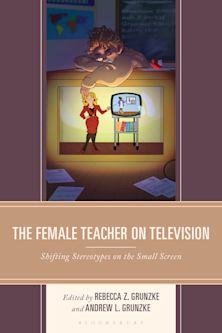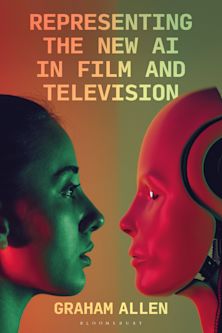- Home
- ACADEMIC
- Film & Media
- Television
- How Television Shapes Our Worldview
How Television Shapes Our Worldview
Media Representations of Social Trends and Change
Deborah A. Macey (Anthology Editor) , Kathleen M. Ryan (Anthology Editor) , Noah J. Springer (Anthology Editor) , Stylés I. Akira (Contributor) , Lane Clegg (Contributor) , Cindy Conaway (Contributor) , Katherine A. Foss (Contributor) , Charity Fox (Contributor) , Carrie Packwood Freeman (Contributor) , Jennifer Ellen Good (Contributor) , Robert D. Gratz (Contributor) , Chandler Harris (Contributor) , Tim Karis (Contributor) , Katherine J. Lehman (Contributor) , Lauren Lemley (Contributor) , Joy Chavez Mapaye (Contributor) , Gretta Moody (Contributor) , Michelle Napierski-Prancl (Contributor) , Ariadne Alejandra Gonzalez (Contributor) , Larry Ossei-Mensah (Contributor) , Leighton C. Peterson (Contributor) , Ji Yoon Ru (Contributor) , Danielle E. Williams (Contributor) , Susan H. Sarapin (Contributor) , Glenn G. Sparks (Contributor) , Margaret Tally (Contributor) , Deborah A. Macey (Contributor) , Kathleen M. Ryan (Contributor) , Noah J. Springer (Contributor) , Jack A. Barwind (Contributor) , Philip J. Salem (Contributor) , Edward Janak (Contributor)
How Television Shapes Our Worldview
Media Representations of Social Trends and Change
Deborah A. Macey (Anthology Editor) , Kathleen M. Ryan (Anthology Editor) , Noah J. Springer (Anthology Editor) , Stylés I. Akira (Contributor) , Lane Clegg (Contributor) , Cindy Conaway (Contributor) , Katherine A. Foss (Contributor) , Charity Fox (Contributor) , Carrie Packwood Freeman (Contributor) , Jennifer Ellen Good (Contributor) , Robert D. Gratz (Contributor) , Chandler Harris (Contributor) , Tim Karis (Contributor) , Katherine J. Lehman (Contributor) , Lauren Lemley (Contributor) , Joy Chavez Mapaye (Contributor) , Gretta Moody (Contributor) , Michelle Napierski-Prancl (Contributor) , Ariadne Alejandra Gonzalez (Contributor) , Larry Ossei-Mensah (Contributor) , Leighton C. Peterson (Contributor) , Ji Yoon Ru (Contributor) , Danielle E. Williams (Contributor) , Susan H. Sarapin (Contributor) , Glenn G. Sparks (Contributor) , Margaret Tally (Contributor) , Deborah A. Macey (Contributor) , Kathleen M. Ryan (Contributor) , Noah J. Springer (Contributor) , Jack A. Barwind (Contributor) , Philip J. Salem (Contributor) , Edward Janak (Contributor)
You must sign in to add this item to your wishlist. Please sign in or create an account
Description
Over the last half of the twentieth century, television has become the predominant medium through which the public accesses information about the world. Through the news, situation comedies, police dramas, and commercials, we learn about the world around us, and our role within it. These genres, narratives, and cultural forms are not simply entertainment, but powerful socializing agents that show the world as we might never see it in real life. How Television Shapes Our Worldview brings together a diverse set of scholars, methodologies, and theoretical frameworks to interrogate the ways through which television molds our vision of the outside world. The essays include advertising and public relations analyses, audience interviews, and case studies that touch on genres ranging from science fiction in the 1970s to current “reality” television. Television truly provides a powerful influence over how we learn about the world around us and understand its social processes.
Table of Contents
Deborah A. Macey, Kathleen M. Ryan and Noah J. Springer
Section I: Not Necessarily the News
2. A Bigger Screen for a Narrower View
Jack A. Barwind, Philip J. Salem, and Robert D. Gratz
3. Measuring the Messenger: Analyzing Bias in Presidential Election Return Coverage
Kahtleen M. Ryan, Lane Clegg, and Joy C. Mapaye
4. Television, Islam, and the Invisible: Narratives on Terrorism and Immigration
Tim Karis
Section II: Boy (and Girl) Meets World
5. “Your Dreams Were Your Ticket Out:” How Mass Media’s Teachers Constructed One Educator’s Identity
Edward A. Janak
6. Defying Gravity: Fox’s Glee Provides a Forum for Queer Teen Representation
Katherine J. Lehman
7. Friendship and the Single Girl: What We Learned about Feminism and Friendship from Sitcom Women in the 1960s and 1970s
Cindy Conaway and Peggy Tally
Section III: America’s Most Wanted
8. Epic Failures: Media Framing and the Ethics of Scapegoating in Baseball
Chandler Harris and Lauren Lemley
9. Eyewitnesses to TV Versions of Reality: The Relationship between Exposure to TV Crime Dramas and Perceptions of the Criminal Justice System
Susan H. Sarapin and Glenn G. Sparks
10. Paramilitary Patriots of the Cold War: Women, Weapons, and Private Warriors in The A-Team and Airwolf
Charity Fox
Section IV: The More You Know
11. Lisa and Phoebe, Lone Vegetarian Icons: At Odds with Television’s Carnonormativity
Carrie Packwood Freeman
12. Television and the Environment: More Screen–Less Green
Jennifer Ellen Good
13. From Welby to McDreamy: What TV Teaches Us About Doctors, Patients, and the Health Care System
Katherine A. Foss
Section V: The Voice
14. Made Impossible by Viewers Like You: The Politics and Poetics of Native American Voices in US Public Television
Leighton C. Peterson
15. “Real” Black, “Real” Money: African American Audiences on The Real Housewives of Atlanta
Gretta Moody
16. He Who has the Gold Makes the Rules: Tyler Perry Presents “The Tyler Perry Way”Danielle E. Williams
17. Viewing 90210 from 12203: Affluent TV Teens Influence a Cohort of Middle Class Women
Michelle Napierski-Prancl
Section VI: Futurama
18. The Construction of Taste: Television and American Home Décor
Stylés I. Akira and Larry Ossei-Mensah
19. Bordertown: Manufacturing Mexicanness in Reality Television
Ariadne Alejandra Gonzalez
20. Cyborgs in the Newsroom: Databases, Cynicism and Political Irony in The Daily Show
Noah J. Springer
Product details
| Published | 15 May 2014 |
|---|---|
| Format | Ebook (Epub & Mobi) |
| Edition | 1st |
| Extent | 462 |
| ISBN | 9780739187050 |
| Imprint | Lexington Books |
| Illustrations | 18 tables |
| Publisher | Bloomsbury Publishing |
About the contributors
Reviews
-
Macey, Ryan, and Springer have compiled essays that examine how television has molded visions of the outside world since the mid-20th century. Since its emergence as a popular form of mass communication, television has served as a primary means of information and cultural storytelling. Through the medium, in all its various genres, narratives, and cultural programs—news, sit coms, police dramas, reality shows—viewers learn about a world they might never see in real life. Pointing to the increasingly fragmented television landscape, the editors organized the essays—all by media scholars—into six main sections: 'Not Necessarily the News,' which considers current affairs; 'Boy (and Girl) Meets World,' the intersection of television with individual lives and social trends; 'America's Most Wanted,' television’s role in perpetuating good and evil; 'The More You Know,' television’s role in social change; 'The Voice,' power and authenticity; and 'Futurama,' which offers a glance at the future. The essays analyze a wide range of shows—Glee, That Girl, Rhoda, Friends, House M.D., M*A*S*H, Welcome Back, Kotter;the numerous theoretical frameworks and methodologies presented suggests that the audience is specialists. The book is a good read. . . .Summing Up: Recommended. Graduate students, researchers, faculty.
Choice Reviews
-
The authors use diverse methodologies, theoretical frameworks, and genres of television to enhance the scholarly application of this book. The editors succeeded in organizing an array of essays on the ways in which television both influences and is influenced by social trends.... This book would be a helpful addition to a course on mass media, the history of television, or diversity in the media... The variety of methods and theoretical frameworks used make the book helpful for a class that is exploring ways to approach the study of media and communication.
International Journal of Communication
-
Because of its range of texts, themes, and critical approaches, this potpourri of essays enriches television scholarship. The ambitious collection examines commercial considerations, such as advertising and audience reception, and social issues, such as images of good and evil. It is a persuasive analysis of information distribution and predictions about what lies ahead in television, which remains a singularly important conduit for dominant and alternative cultural narratives.
Jan Whitt, University of Colorado Boulder
-
This book brings together diverse and highly respected scholars to help demonstrate the powerful influence of television, an increasingly fragmented and fractured media in contemporary culture. It explores institutions, audiences, and cultures through multiple methodologies and theoretical frameworks, offering fascinating new insights into how television molds our perceptions of the world and influences our action within it.
Kathleen German, Miami University

ONLINE RESOURCES
Bloomsbury Collections
This book is available on Bloomsbury Collections where your library has access.



































